Accessibility and inclusion
Our aim
Our aim is to deliver an outstanding service to every customer, making sure that everyone can use our services (as long as it’s safe to do so). That means providing an accessible transport network to all our customers, removing barriers to transport, providing reasonable adjustments, and supporting customers with accessibility and assistance needs.
The Equality Act 2010 (the “Act”) provides legal rights to people to protect them against discrimination in the workplace and in wider society. It provides legal rights in the areas of:
- Employment
- Education
- Access to goods, services and facilities including larger private clubs and land-based transport services
- Buying and renting land or property
- Functions of public bodies, for example, the issuing of licenses
The Act sets out nine characteristics which are protected by the Act against discrimination (see 1.1 “Protected Characteristics” below for a list of the nine characteristics).
The Act also provides rights for people not to be directly discriminated against or harassed because they have an association with a protected characteristic. For example, this can apply to a carer or parent of a disabled person.
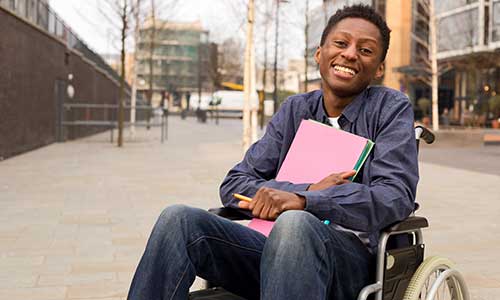
The definition of disability under the Equality Act 2010
Under the Act, a person has a disability if:
- They have a physical or mental impairment.
- The impairment has a substantial and long-term adverse effect on their ability to perform normal day-to-day activities.
We shouldn’t question someone's impairment or disability. Instead, we should focus on what changes or reasonable adjustments we need to do to make sure disabled customers have equal access to our services. This is a legal requirement - please see section 1.2 for more information on Reasonable Adjustments to make for disabled customers.
Consequences if we fail to follow the Equality Act 2010
- Fines and penalties due to not adhering to the law.
- Financial losses resulting from compensation paid to disabled customers and legal fees.
- Disciplinary action against the staff member found to have acted in a deliberately discriminatory manner.
- Negative press and damage to our brand.
- Criminal offence (in certain cases).
Protected characteristics, direct and indirect discrimination
There are nine protected characteristics. A protected characteristic means that it is against the law to discriminate against someone because of:
- Age
- Disability
- Gender reassignment
- Marriage and civil partnership
- Pregnancy and maternity
- Race
- Religion or belief
- Sex
- Sexual orientation
Direct discrimination
This is when a trader or service provider treats any person less favourably than someone else based on one of the above protected characteristics; for example, refusing travel to a customer belonging to a protected group.
Indirect discrimination
This is ‘any provision, criterion or practice that applies to everyone but adversely affects people with a particular protected characteristic (eg. disability) more than others, and is not justified’. For example, requiring a wheelchair user to book in advance where a non-wheelchair user would be able to book on the day.
Harassment
Harassment is a form of discrimination under the Equality Act 2010. Harassment is unwanted behaviour which has the purpose of violating someone’s dignity, offends or makes them feel intimidated or humiliated. It can happen on its own or alongside other forms of discrimination.
Victimisation
Treating someone badly because they have made a claim or complaint of discrimination (or if you believe that a person has done or is going to make a complaint).
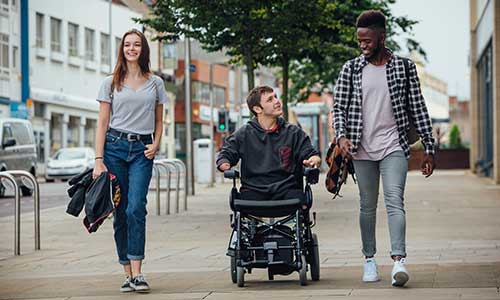
Examples
Here are some examples of direct and indirect discrimination and how they might play out with some of the protected characteristics.
Religion or belief
In Sikhism, the five Ks are five items that Guru Gobind Singh commanded Khalsa Sikhs to wear at all times:
- Kesh
- Kangha
- Kara
- Kachera
- Kirpan
Example: 14-year-old S Singh won a High Court case against her school after it excluded her for breaking its "no jewellery" rule for wearing a Kara (steel bangle), a symbol of Sikh faith. The school was found guilty of indirect discrimination.
Disability
- Campbell v Thomas Cook Tours: Mrs Campbell suffered from arthritis and had difficulty walking and standing. She took a holiday to Tunisia with Thomas Cook but, on her return to the UK, had to wait at the Tunisian airport for four hours. Mrs Campbell wasn’t given any seating or wheelchair facilities. As a result, she suffered migraines, pain and vomiting.
The Court found, which was upheld on appeal, that Thomas Cook had failed to make reasonable adjustments for Mrs Campbell. They should have supplied seating or asked other passengers to move ahead in the queue. She was awarded compensation against Thomas Cook. This is an example of indirect discrimination.
Racial
A club was found guilty of direct discrimination after refusing entry to a male attempting to enter the club. He was the only non-white person in his group and all but him were allowed entry.
Race
In the Equality Act, race can mean your colour or your nationality (including your citizenship). It can also mean your ethnic or national origins which may not be the same as your current nationality. For example, you may have Chinese national origins and be living in Britain with a British passport.
In the case of Dziedziak v Future Electronics Ltd 2012, a Reading Employment Tribunal held that there was an act of direct discrimination on the grounds of nationality when a line manager told Ms Dziedziak, who was Polish, to not use "her own language" at work.
We must respect all customers and their rights to communicate in other languages.
Maternity
A customer is breastfeeding her three-month-old baby on a coach. The driver asks her to breastfeed their baby in the toilets, as one of the customers has complained about it.
This is unlawful pregnancy and maternity discrimination. That means that under the Equality Act 2010, mothers are allowed to breastfeed an infant on board the coach.
The Equality Act recognises that bringing about equality for disabled people may mean changing the way in which services are delivered, providing extra equipment and/or the removal of barriers. This is our legal duty ‘to make reasonable adjustments’.
We are required to make reasonable adjustments to ensure that disabled customers can use our services as close as is reasonably possible to get to the standard usually offered to non-disabled people.
It is always best to ask customers if they have any reasonable adjustments or accessibility requirements. Examples of adjustments might include:
- Giving a customer a disruption card if they are unable to access announcements.
- Providing additional stops for customers who require an accessible toilet.
- Asking non-disabled customers to vacate a space which is reserved for wheelchair users.
- Providing announcements in alternative formats.
- Adjusting the temperature.
- Moving luggage where practically possible for customers who require this as an adjustment.
Example
A customer has a severe nut allergy and contacts the Assisted Travel team. The team ask what assistance or adjustments the customer requires. The customer suggests we inform all customers on board of their nut allergy and request that no nuts are consumed on board. The Assisted Travel team sends the request to the driver via a driver’s note and informs the customer of the risks (such as non-English speaking customers not understanding). Having been informed of the risks and that we cannot guarantee the request is followed or understood by other customers, the customer is happy to go ahead with the journey based on the driver carrying out this reasonable adjustment.
Customers don’t have to pre-book assistance before travelling with us; although it is something we recommend. Accessible travel information should be provided both before and during the journey. Bus and coach operators legally have to organise mandatory disability awareness training for all drivers. There is also a right to compensation for damaged wheelchairs or other assistive equipment and information about passenger rights will become available in terminals and online.
If you have a customer who has booked their assistance in advance you must:
- Call for or attend to customers requiring assistance first.
- Load and unload their luggage.
- If a customer needs the Magic Seat removing, please make sure this is done.
- When required, provide assistance on and off the coach by either giving a steady arm for the customer to hold while they board and disembark the coach OR use the lift.
- Under no circumstances is anyone permitted to stand on the lift whilst it is in use.
- If they have booked their assistance in advance, their wheelchair will have already been cleared as safe to carry on the coach.
For customers transferring to a seat, having pre-booked assistance, our Assisted Travel team in the Contact Centre will have reserved a front seat for the customer, subject to availability and requirement. This is, however, a request and not a guarantee - that person could be asked to move to another seat if someone else boards (e.g. a wheelchair user) the coach further along the journey and is perceived to have a greater need (although this is rare).
Please note, if all four front seats are booked or taken, you can explain that seat allocation is done on a ‘first come, first served’ basis. You should offer alternative seats on the coach and the customer can travel if they are happy to sit elsewhere.
This does not apply to customers in wheelchairs who can only travel in the allocated seats on the coach (making sure they are safely secured for travel). If a seat is taken by a non-wheelchair user, you should politely ask them to move seats (if there is room) and accept the customer using a wheelchair for travel.
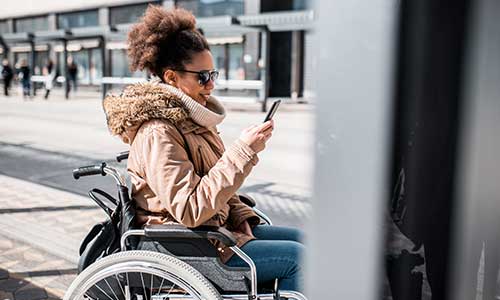
Connections
When customers connect from one National Express service to another, coach station staff will assist the customer from one coach to the next, subject to availability. In the case of London Victoria coach station (VCS), the staff (employed by Transport for London) will provide ‘connection assistance’. (Please inform your customer that if they accept luggage assistance from the self-employed porters in VCS, there is a charge for this service and is not part of our service provision).
When the inbound coach comes into the arrivals hall, drivers should ask a member of staff (based in the arrivals hall) to radio across to someone in the mobility lounge. That person will then come to assist the customer to either the departure gate of their next coach or to the mobility lounge if there is a long wait. The staff member will also assist the customer from the mobility lounge to their coach departure bay when it’s time for their next coach.
Wheelchair User Flowchart
If a customer in a wheelchair requests travel and they HAVE NOT booked assistance in advance, follow the guidelines in the flowchart:
Download Wheelchair User Flowchart [PDF]
- Ask the customer if they have booked in advance and assist as necessary. Assistance can’t be refused on the basis that they’ve not booked in advance.
- If the customer is in a wheelchair and has not booked in advance, politely ask for the make and model of their wheelchair and explain that you will need authorisation that it is safe and compatible for/with the coach they will be travelling on.
- Please also consider any onward connections.
- NCC hold a list of compatible wheelchairs on their database and can confirm if you’re able to take the customer with that particular make/model of wheelchair. If we don’t hold the details of their wheelchair on our system, you may have to ask the customer for the dimensions of their wheelchair to make sure we are able to carry them securely.
Guidance
- We recommend that drivers don’t touch the customer’s wheelchairs; ideally, this should be left to the customer’s friends or family as our staff are not trained in providing wheelchair assistance. However, this should never stop you offering good customer service and we should push wheelchairs safely if there is no-one else available and if the customer agrees/requests this.
- You will need to help manoeuvre the wheelchair once onboard the coach to make sure it’s securely fastened to the vehicle before setting off. Always ask the customer first if they are happy for you to do this.
- If you are ever unsure of the right steps to take, take advice from NCC and follow their instructions.
Generally, whenever dealing with an assisted travel booking, please follow the guidelines below:
- Always read your driver’s notes before starting service.
- Never lift a customer in or out of their wheelchair yourself. The customer’s carer may do this (if it is safe).
- Always contact NCC if the lift develops a fault en route (lifts must always be fully deployed before starting service as part of walk-around checks).
- For safety reasons, all types of wheelchair must be assessed and authorised for travel. If you are in any doubt about the checks, call the Assisted Travel team or NCC for advice immediately.
- Never make a non-procedural decision without consulting a member of National Express site staff or calling NCC. It’s safer and more responsible to ask for help than deal with an issue on your own.
- If a disabled customer wants to leave the coach when a scheduled stop at the services has been made, they must be treated like all other customers and be allowed to do so.
- If you are handing a coach over to another driver, make sure you pass on all information relating to any customer(s) requiring assisted travel and/or reasonable adjustments.
- Always talk to customers directly and make eye contact. Don’t talk to disabled customers through their companion or personal assistant.
- Ask “Would you like any help?” Many customers don’t need any extra help, so consider the customer’s situation and offer help if you feel it may be required. Not all customers will need help and can manage by themselves.
- Only provide help if required.
- Park as close and as square to the kerb as possible when stopping.
- Lower any kneeling devices that are fitted to the vehicle.
- Help with loading luggage.
- Check that all customers are seated before pulling away from a stop.
- Where necessary deploy ramps or lifts.
- Make sure that you are up-to-date with disability awareness training, company policy and training regarding the deployment of ramps and/or lifts.
- Make sure you correctly know how to anchor a wheelchair to the restraint system. Failure to do this could result in legal action.
- Remember that wheelchairs must be carried within the hold of the coach if the customer is transferring to a seat.
- Never administer medication to any customer.
- Never physically carry customers in or out of the vehicle, although a supporting arm may be offered.
Offering assistance – supporting blind customers and customers with visual impairments
- If assistance is required, introduce yourself by name and ask directly what you need to do.
- Offer to describe their surroundings, detailing steps, handrails, obstacles and layout.
- Offer to guide the customer, allowing them to take your arm.
- Offer support to be seated, placing their hand on the back of the chair, telling them what you have done and pointing out useful areas like device charging points and seatbelts.
- Verbally communicate when necessary; for example, telling the customer when you are leaving them and when you will return (if appropriate).
Offering assistance – supporting deaf customers or customers with hearing impairments
- Establish the best way the customer would like to communicate.
- Make eye contact and speak clearly and naturally.
- Facial expressions, visual cues and gestures may support customers who are deaf or have hearing impairments; do not over exaggerate.
- If an audible announcement or warning is made, inform the customer so they understand what is happening.
Offering assistance – speech impairments
Don’t finish the ends of a customer’s sentences, or pretend to understand them when you do not. Always politely ask them to repeat themselves, even if it takes several attempts.
Assistance - seating
- If a disabled customer has reserved the front seat you must give them access to this. The customer might not appear to be disabled; however, you should not question this and allow them to use the front seats.
- If the seats are not booked non-disabled customers can sit here. They will have to give up this space for a wheelchair user / disabled customer. It’s important that you don’t reserve these seats for yourself or co-driver.
- Always offer to help a customer who appears to have a disability to their seat and, if a customer requests support to their seat, provide this.
- Introduce yourself by giving your name and explaining that you are their National Express driver. Make sure that they are seated comfortably and assist them where necessary. In particular, check that they have secured their seatbelt and offer assistance if required.
- Customers with assistance dogs should be seated in the front section of the coach where there is most legroom. Ideally, they should have both seats in that section. However, if there is only one seat give the customer the choice of travelling on the next service or the dog sitting under the seat (dependent on the length of the journey). For safety reasons, assistance dogs must not travel in the aisle.
Wheelchair users (including National Express-owned wheelchairs to transfer)
You can help provide a reliable coach service by being prepared for wheelchair users:
- Always treat the person with respect and be aware of their needs and wishes.
- Make sure you know the location of wheelchair spaces on the coach and that you know how to remove seats and deploy lifts.
- When talking to a wheelchair customer kneel or meet their eye level.
Wheelchair users - guidance
Turn-up and go on the day of travel – customers remaining in their wheelchair
Carry out the following steps before travel is booked for the customer. If in doubt at any stage of this process, call NCC for advice.
- Politely ask the customer if they wish to remain in their wheelchair for the duration of the journey or if they intend to transfer to a coach seat.
- If the customer does wish to remain in their wheelchair (in the wheelchair user space) you will need to call NCC to carry out certain checks to confirm if the customer can travel. If the wheelchair user wishes to transfer to the coach seat, follow the process in section B below.
- Explain the following to the customer so they understand what is happening while they wait to be boarded:
- “I will just make a call to our Network Control Centre (NCC) who will carry out some compatibility checks on your wheelchair to make sure we can carry you safely on your journey. Can you please confirm the make and model of your wheelchair and whether any modifications have been made to it?”
When speaking to NCC they will ask you for the wheelchair make and model (which you’ll get from the customer) so that the following information can be checked:
- The customer’s wheelchair is compatible with the wheelchair space on the coach.
- The combined weight of the customer and the wheelchair does not exceed the maximum weight capable of being lifted by the wheelchair lift.
- The stops at which the customer wishes to board and alight the coach are accessible stops where the wheelchair lift can be deployed.
- The particular coach on which the customer wishes to travel is not already fully booked; and
- The wheelchair space has not already been booked by another wheelchair user for travel in their wheelchair for the whole or part of the journey that the customer wishes to take.
If these requirements are met, prepare the coach for travel by removing the Magic Seat (if it needs to be removed), from the wheelchair space to enable the customer to travel securely in their wheelchair. If you are in any doubt as to how to remove the Magic Seat speak to a member of staff or NCC at the time, and then arrange re-training for a later date. If any of the above requirements are not met go to the penultimate paragraph in this section.
If another customer (non-disabled or disabled) is already sitting in the Magic Seat, politely ask them to move to another available seat on the coach. However, if that customer is disabled then consider whether they may have mobility issues and whether asking them to move to another seat is practical or possible. If they don’t agree to move, please call NCC for further advice.
Deploy the wheelchair lift to board the customer and safely secure the wheelchair and the customer in the wheelchair space using the harness provided before embarking on the journey. Always ask the customer if they are happy for you to move them before manoeuvring their wheelchair.
When the customer has arrived at their destination, release the wheelchair from the wheelchair user space when the customer wishes to leave the coach. There may be occasions when the customer wants to get off the coach during the journey. If there isn’t a suitable planned break along the journey that meets the customer’s requirements, don’t refuse the customer’s request. This could amount to a failure to make reasonable adjustments for the customer. For example, all other customers can use the on-board toilet, but clearly this would not be possible for a wheelchair user. Please call NCC for advice on stopping at the nearest safe location.
If the compatibility requirements are not met, NCC will talk you through why it’s not possible to carry the customer on this occasion. You will need to relay this information accurately to the customer. If they have bought a ticket before travel, please direct them to a coach station member of staff who will organise a full refund of the ticket. Or, if at a non-staffed stop, advise the customer to get in touch with the customer service team by calling 03717 81 81 81 or go to the website for other ways of making contact with us.
If the compatibility requirements are met but you are unable to load the wheelchair or safely secure it on the coach, call NCC who will advise you on how to proceed.
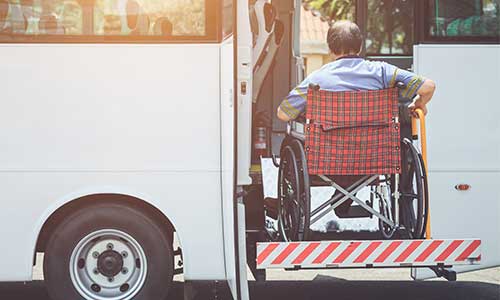
Turn-up and go on the day of travel – transferring from a wheelchair to a coach seat
Follow the steps set out below to make sure the relevant compatibility checks (on wheelchairs and coach stop departure and arrival points) are carried out before travel is booked for the customer. If in doubt at any stage of this process, call NCC for advice.
Confirm that the customer wishes to stow their wheelchair in the luggage hold and transfer to a coach seat. If the customer wants to travel in their wheelchair, in the wheelchair space on the coach, you must follow the guidance provided in the section above.
If the customer wants to transfer to a coach seat and stow their wheelchair in the luggage hold, you will need to call NCC to check that the stops where they want to board and disembark are accessible stops where the wheelchair lift can be deployed. You will also need to confirm (by asking the customer for information about their wheelchair) that the wheelchair is safe for stowage.
Explain the following to the customer so that they understand what is happening whilst they wait to be boarded.
“I will just make a call to our Network Control Centre (NCC) who will carry out some checks to make sure that the stops you wish to use are wheelchair accessible stops where the wheelchair lift can be safely deployed. I will also need to ask you for certain information about your wheelchair to check that it can be safely stowed in the hold.”
Contact NCC to carry out these checks. If the stops are not accessible stops and/or there is no space on the coach go to the final paragraph in this section, below.
To check that the wheelchair is safe for stowage, ask the customer to confirm that the wheelchair:
- Is capable of being folded and unfolded.
- If it can’t be folded, it can be dismantled and reassembled by the wheelchair user’s carer/companion.
- If it has a battery, the battery is a dry fuel cell, gel fuel cell or lithium battery.
- Has no assistance or auxiliary aids (modifications) which would make it unsafe for stowage
- Weighs no more than 20kg.
If the wheelchair does not meet all of the above requirements go to the final paragraph in this section below.
If the stops which the wheelchair user wishes to use are wheelchair accessible (where the wheelchair lift can be safely deployed), there is space on the coach and the wheelchair meets the requirements listed above:
- Use the wheelchair lift to board the customer.
- Assist the customer to their seat.
- Provide reasonable assistance to the customer in folding down their wheelchair.
- Store the wheelchair in the hold.
When the customer has arrived at their destination, provide reasonable assistance in unfolding the wheelchair (take advice from the customer on how to do this). There may be occasions when the customer wishes to disembark during the journey. If there is not a suitable planned break along the journey, which meets the customer’s requirements, don’t refuse the customer’s request. Call NCC for advice on stopping at the nearest safe location.
If the stops which the customer wants to use are not accessible stops, there is no space on the coach, or the wheelchair is not safe for stowage in the luggage hold, NCC will tell you how to proceed. If the customer has bought a ticket before travel direct them to a coach station member of staff who will organise a full refund of the ticket. Or, if at a non-staffed stop, advise the customer to get in touch with the customer service team by calling 03717 81 81 81 or go to the website for other ways of making contact with us.
Turn-up and go on the day of travel – using a National Express wheelchair
Follow the steps below to make sure the relevant compatibility checks, regarding coach stop departure and arrival points, are carried out before travel is booked for the customer. If in doubt at any stage of this process, call NCC for advice.
- Confirm that the customer wishes to board using a National Express wheelchair and transfer to a coach seat.
- If the customer wishes to use a National Express Wheelchair and transfer to a coach seat you will need to call NCC to check the stops where the customer wants to board and disembark the coach are wheelchair accessible stops where the wheelchair lift can be deployed.
Explain the following to the customer so they understand what is happening while they wait to be boarded.
“I will just make a call to our Network Control Centre (NCC) who will carry out some checks to make sure that the stops you wish to use are wheelchair accessible stops where the wheelchair lift can be safely deployed.”
- Contact NCC to carry out the checks. If the stops are not wheelchair accessible stops and/or there is no space on the coach go to the final bullet point below;
- If the stops which the wheelchair user wishes to use are wheelchair accessible stops where the wheelchair lift can be safely deployed, and there is space on the coach;
- Use the wheelchair lift to board the customer.
- Help the customer to their seat.
- Stow the National Express Wheelchair in the luggage hold. Under no circumstance are customers able to travel in the National Express wheelchair.
- Provide any other reasonable assistance to the customer.
- When the customer has arrived at their destination, take the National Express wheelchair from the luggage hold and help the customer to disembark using the wheelchair lift. There may be occasions when the customer wishes to get off the coach during the journey. If there is not a suitable planned break along the journey that meets the customer’s requirements, don’t refuse the customer’s request. Call NCC for advice on stopping at the nearest safe location.
- If the stops which the customer wants to use are not accessible stops or there is no space on the coach, NCC will advise you on how to proceed. If the customer has bought a ticket before travel, direct the customer to a coach station member of staff who will organise a full refund of the ticket. Or, if at a non-staffed stop, explain that the customer can get in touch with the customer service team by calling 03717 81 81 81 or go to the website for other ways of making contact with us.
Foldable wheelchairs
Follow the steps below to ensure the relevant compatibility checks, on wheelchairs and coach stop departure and arrival points, are carried out before travel is booked for the customer. If in doubt at any stage of this process, call NCC for advice.
- Confirm that the customer wants to stow their wheelchair in the luggage hold and transfer to a coach seat. If the customer wants to travel in their wheelchair, in the wheelchair space on the coach, follow the process.
- If the customer wishes to transfer to a coach seat and stow their wheelchair in the luggage hold call NCC to check the stops where the customer wants to board and disembark are accessible stops where the wheelchair lift can be used. You will also need to confirm (by asking the customer for information about their wheelchair) that the wheelchair is safe for stowage.
- Explain to the customer so they understand what is happening whilst they wait to be boarded.
“I will just make a call to our Network Control Centre (NCC) who will carry out some checks to make sure that the stops you wish to use are wheelchair accessible where the wheelchair lift can be safely used. I will also need to ask you for certain information about your wheelchair to check that it can be safely stowed in the hold.” - Contact NCC to carry out the checks. If the stops are not accessible stops and/or there is no space on the coach go to point 8 below.
- Check that the wheelchair is safe for stowage by asking the customer to confirm that the wheelchair:
- Is capable of being folded and unfolded.
- If it can’t be folded, it can be dismantled and reassembled by the wheelchair user’s carer/companion.
- If it has a battery, the battery is a dry fuel cell, gel fuel cell or lithium battery.
- Has no assistance or auxiliary aids (modifications to the wheelchair) which would make it unsafe for stowage.
- Weighs no more than 20kg.
- If the wheelchair does not meet all the above requirements go to point 8 below.
- If the stops which the wheelchair user wants to use are wheelchair accessible stops (where the wheelchair lift can be safely used), there is space on the coach and the wheelchair meets the requirements in point 5:
- Use the wheelchair lift to board the customer.
- Assist the customer in their seat.
- Provide reasonable assistance to the customer in folding down their wheelchair and store the wheelchair in the hold.
- When the customer has arrived at their destination, provide reasonable assistance by unfolding the wheelchair and take advice from the customer on how to do so. There may be occasions when the customer wants to disembark during the journey. If there isn’t a suitable planned break along the journey which meets the customer’s requirements, don’t refuse the customer’s request. Call NCC for advice on stopping at the nearest safe location.
- If the stops which the customer wants to use are not accessible stops, there is no space on the coach, or the wheelchair is not safe for stowage in the luggage hold, NCC will tell you how to proceed. If the customer has bought a ticket before travel, direct them to a coach station member of staff who will organise a full refund of the ticket. Or, if at a non-staffed stop, to the customer that they can get in touch with the Customer Service team by calling 03717 81 81 81 or go to the website for other ways of making contact with us.
We accept small mobility scooters and powered wheelchairs for stowage in the hold of the coach subject to the following:
- The customer can travel if their wheelchair/mobility scooter is compatible, there is space on the service and the service route is accessible. Contact NCC and follow the wheelchair user boarding guidelines.
- When notifying the contact centre, customers provide us with the details of the size and make of the powered wheelchair/scooter to enable checks to be made on the manufacturer’s website to ensure that it is suitable for stowage in the hold of the coach.
- We will advise the customer, either at the time or by calling them back, about the suitability of their scooter/ powered wheelchair for stowage in the hold of our coaches.
- The scooter or powered wheelchair will break down into separate parts, each weighing no more than 20kgs.
- A powered wheelchair can be stowed in the hold of the coach and is subject to the same conditions as a scooter.
- For the purpose of dismantling and reassembling the powered wheelchair/scooter, the customer must be accompanied at the point of departure and arrival by a companion who is able to complete this task to enable safe stowage in the coach hold. Or the customer is able to dismantle and reassemble the powered wheelchair/scooter themselves.
- The powered wheelchair/scooter is operated by dry cell or gel type batteries only.
Follow the steps below before travel is booked for the customer. If in doubt at any stage of this process - call NCC for advice.
- Call NCC to check the information about the mobility scooter; keep the customer informed and explain what you are doing:
“I will just make a call to our Network Control Centre (NCC) who will carry out some compatibility checks on your mobility scooter to make sure we can carry this safely in the hold of the coach for your journey.” - NCC will ask you to check the mobility scooter is safe for stowage by asking the customer to confirm that the mobility scooter:
- Is capable of being folded and unfolded.
- If it can’t be folded, it can be dismantled and reassembled by the customer or their carer/companion.
- If it has a battery, the battery is a dry fuel cell, gel fuel cell or lithium battery and the heaviest part of the mobility scooter weighs no more than 20kg.
- If the mobility scooter does not meet the above requirements go to point 4 below.
- If you can confirm that a mobility scooter is safe for stowage in the luggage hold, then safely stow it in the hold and let the customer board the coach. Never allow a customer to travel on their mobility scooter in the wheelchair space or allow the mobility scooter on the wheelchair lift.
- If the mobility scooter is not safe for stowage in the luggage hold, call NCC for advice on how to proceed. If the customer has bought a ticket before travel, direct them to a coach station member of staff who will organise a full refund. Or, if at a non-staffed stop, explain that the customer can get in touch with the customer service team by calling 03717 81 81 81 or go to the website for other ways of making contact with us.
We welcome trained assistance dogs on all our coaches.
We are unable to carry dogs or any other animals on our coaches.
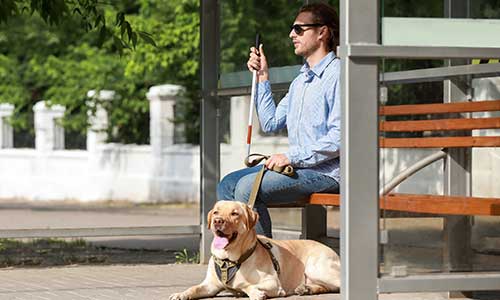
Customers don’t have to pre-book an assistance dog onto the coach. However, we do recommend this to customers to ensure there will be space available on the service they require and to avoid disappointment. Drivers should not insist on a customer having first pre-booked assistance or prevent them from travelling if they have not.
Assistance dogs have to wear a safety harness when on board the coach which is then attached to the seatbelt of a spare seat. The customer has to provide the safety harness. If they don’t have one with them, do not refuse travel but contact NCC for further support. The safety harness keeps the customer’s assistance dog (as well as our driver and other customers onboard) safe if there’s an emergency stop. You may need to assist a customer and harness their assistance dog in safely. Please refer to the safe working practice for assistance dogs.
If a customer has not pre-booked you should ask the customer to confirm that their assistance dog is highly trained by producing evidence, for example, a certificate, correspondence from the training organisation, ID book, owner training logs or an email from the owner confirming what training has taken place. If you are unsure you should contact NCC for additional guidance.
Under the Equality Act 2010, there is a legal obligation to provide reasonable adjustments to enable disabled customers to access our services. You will be required to provide any reasonable adjustments and assistance when requested by the customer.
In any case, where a dog might display aggressive behaviour, drivers are able to refuse travel in line with Health and Safety. The failure to exercise this discretion reasonably and without good evidence may result in the driver being removed from the National Express network.
If you have a known allergy to dogs, medical evidence from a GP, of the diagnosed allergy, must be provided to your direct employer so that this can be recorded for future reference.
If you have an allergy and/or phobia to dogs to the extent that such allergy would prevent you from driving whilst transporting an assistance dog you must:
-
Provide evidence to your line manager/supervisor including by reference to a medical note from your GP of your allergy if you have not already done so; and
-
If the customer has booked in advance and notified National Express of their intention to travel with an assistance dog, you must notify the Assisted Travel Team 03717818181 and the relevant Operations Manager so that we can rotate you for a different driver (who does not have such allergy/phobia); or
-
Where the customer has not pre-booked, you should contact NCC who will arrange alternative transport for the customer.
Some customers can only travel on our services if they are accompanied by a carer (because of their disability), such Carer must travel). In this case, the carer travels free of charge. If the customer and the carer have not pre-booked and want to travel, you must contact NCC.
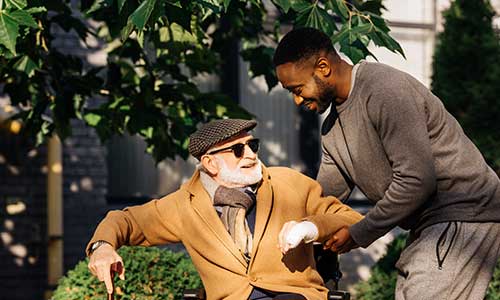
To avoid non-disabled people abusing the free carers’ scheme, NCC may ask you to ask the customer to provide evidence showing that they require a carer to travel, but if they do not have such evidence please contact NCC for further guidance. This evidence can take a variety of forms; for example, (this is a non-exhaustive list):
- GP’s letter
- Evidence of Disability Living Allowance
- Attendance Allowance
- Personal Independent Payments (PIP)
- Blue Badge Holder certificate
- Carers’ Allowance
Invisible impairments, disabilities and mental health awareness
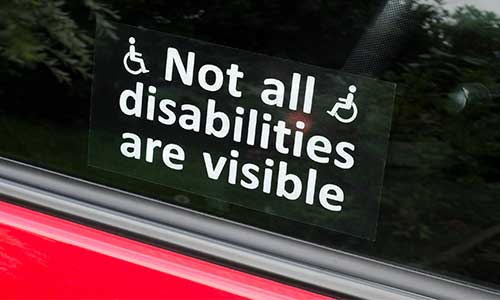
Not all disabilities/impairments are visible and it is important that you remember that not everyone’s requirements are the same. There are many different types of disabilities, impairments and long term health conditions. These could be physical or mental impairments and can include:
- Physical impairments, such as mobility difficulties.
- Sensory impairments, such as those affecting hearing or sight.
- Learning difficulties, including people with specific learning difficulties such as dyslexia and dyspraxia.
- Mental health conditions or illnesses which have a long-term effect, such as depression and anxiety, panic attacks, phobias, eating disorders, obsessive-compulsive disorders, schizophrenia and bipolar affective disorder.
- Genetic and progressive conditions (if the condition affects your ability to carry out normal day-to-day activities such as motor neurone disease and muscular dystrophy).
- Conditions which are characterised by a number of cumulative effects such as pain or fatigue.
- Hidden impairments such as asthma, diabetes or arthritis (if these have an effect on day-to-day activities).
This list is not exhaustive and there are other groups who may require assistance in their journey such as older adults, those travelling with heavy or multiple luggage or customers who speak little or no English. Other groups can include people who have dyslexia, autism, ADHD, dyspraxia and other neurological conditions. These are 'spectrum' conditions, with a wide range of characteristics.
Just as all our customers are all different and individuals, the way they may communicate can be different. Some customers may have:
- Different eye contact (for example, will not look a person directly in the eye and avoid all eye contact or stares for long periods of time).
- Appear withdrawn and low in confidence.
- Agitated body movements.
As with all aspects of your customer service role, you should be polite and helpful when dealing with our customers. Keep an eye out as you move through the station for potential, vulnerable customers who may need extra help, information or reassurance.
‘Implicit’ or ‘unconscious bias’ happens when our brains making incredibly quick judgments and assessments of people and situations without us realising. Our biases are influenced by our background, cultural environment and personal experiences.
We may not even be aware of these views and opinions or realise their full impact and implications.

Real examples of how bias can play out on our network
- A customer forgets their coach card. A driver might impose the rule that they have to purchase a full price ticket. This same situation could happen to another customer who the driver might apply discretion to.
- A customer has a suitcase which the driver thinks is over the weight limit but there’s no quantifiable way to check this, so the driver might impose a fine. Another customer could have the same situation and the driver might apply discretion and not charge them.
In all of these situations, your brain has made decisions and assumptions about how to treat these people differently. Therefore, prior to making a decision, please consider whether you would make that same decision for all customers.
Some customers who we come into contact with will be vulnerable in the context of how we interact with them, by virtue of their personal circumstances. We have a duty and obligation to ensure that all elements of our work are consistent with our values and that we make reasonable adjustments.
The type of vulnerability can vary widely; for example, a young person with autism living independently for the first time, or a single parent with dependent children who has recently become unemployed, or someone with a terminal illness. “Vulnerability” can be permanent, temporary or progressive.
Some examples of vulnerable customers might include:
- Dementia
- Alzheimer’s
- Learning disability
- Young people in the care of social services
- Child passenger(s) travelling alone (14-15 year old)
If you have any concerns regarding customers please contact NCC. If you have immediate concerns regarding customers please call the police.
Communicating in a positive, effective way with customers can really add to their National Express experience.
If you’re communicating with customers who don't speak English as their first language:
- Speak clearly and pronounce your words correctly.
- Don’t think shouting/increasing the volume will help people communicate better.
- Don’t cover or hide your mouth because customers might want to watch you as you pronounce your words.
- Avoid slang/jargon e.g. ‘VCS’ for ‘Victoria Coach Station’.
- If asked to repeat something, first repeat it as you said it the first time.
- Avoid using contractions or short forms (for example, say ‘cannot’ rather than ‘can’t).
- Avoid speaking over the customer.
- Listen and try not to form your reply while the other person is talking.
- Be patient, polite and friendly.
- Be clear: say “Yes” or “No”. Do not say: “Uh-huh” or “Uh-uh”.
Use positive language with all customers. When talking about impairments, requirements or needs of disabled customers, avoid phrases like ‘suffers from’ which suggests discomfort, constant pain and a sense of hopelessness. Wheelchair users may not view themselves as ‘confined to a wheelchair’– try thinking of it as a mobility aid instead.
People themselves are not necessarily disabled; it is society, services and the world around us all that can be disabling for some. The word ‘disabled’ is a description not a group of people. Use ‘disabled people’ not ‘the disabled’ as the collective term.
These are examples of words we should move away from using and what we can replace them with.
| Stop saying... | Replace with... |
|---|---|
| Wheelchair bound | Wheelchair user |
| Able bodied | Non-disabled |
| Suffers from | Lives with |
| Person with disability | Disabled person |
| (the) handicapped, (the) disabled, person with disabilities |
Disabled (people) |
| Afflicted by, suffers from, victim of | Has/lives with [name of condition or impairment] |
| Confined to a wheelchair | Wheelchair user |
| The blind | People with visual impairments; blind people; blind and partially sighted people |
| ‘In this country /my country’ | We receive many complaints about drivers saying things such as ‘We have rules in this country’ etc. If you say things like this, you are making an assumption about the individual based on your perception of them. This can be a way in which our unconscious biases play out. Used in many contexts this term can be offensive |
